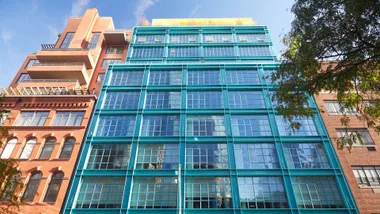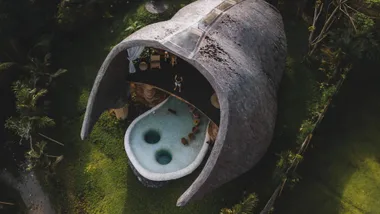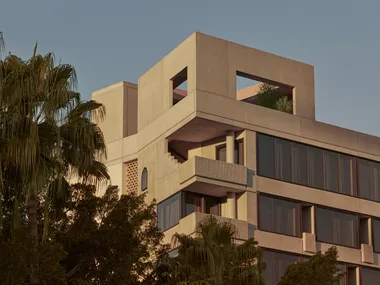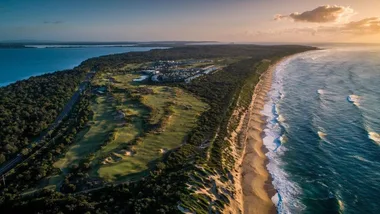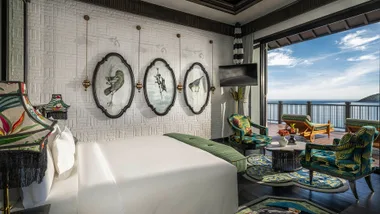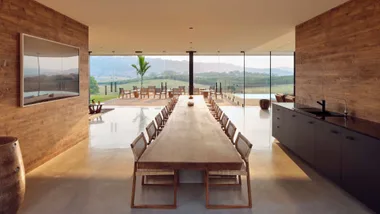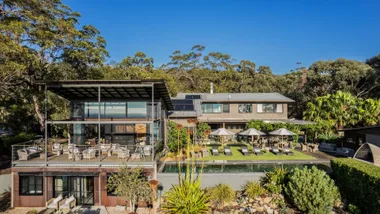GETTING THERE
Virgin Australia operates 22 flights a week to Nadi, Fiji, from Sydney, Melbourne and Brisbane. The airline has recently added new widebody A330 aircraft to the route, with full business-class service.
The transfer to Dolphin Island involves a 2.5-hour drive to Ellington Wharf on the northern tip of Viti Levu, then a 20-minute boat ride. Or take a direct seaplane charter.
STAYING THERE
Dolphin Island costs from $1256 per person per night for eight guests, or $1750 per person per night for two people. The tariff includes transfers from Nadi, all meals, drinks and water sports. There are extra costs for excursions, spa treatments, and cooking and tapa cloth-making classes. There are also combined packages with sister property Huka Lodge, near Lake Taupo, in the central North Island of New Zealand.
Guidebooks on Fiji say that cannibalism in this part of Melanesia went out of fashion more than a century ago. So why, as I settle in this idyllic patch of the South Pacific, do I feel like I’m being fattened for slaughter?
It’s day two of a three-day stay on Dolphin Island, the private-island retreat owned by the proprietors of New Zealand’s luxe Huka Lodge, and I’m sitting in the kitchen of Aunty Meena in the town of Rakiraki on Viti Levu, the main island of Fiji.
We’re at a long table surrounded by pots, teetering towers of empty ice-cream containers and the heady scent of Indian spices. As Aunty Meena tells me about her days as the region’s chief health inspector, she reaches into a large bowl of bhaji mix, scoops out a handful and drops it into a wok of hot oil.
Today she’s cooking for the funeral of a member of the local Sikh community. It will be a modest affair, she says. Only 500 or so. She’s doing most of the catering, because, well, she likes to cook, and they say no one makes bush lemon pickle quite like she does.
Indian music crackles over the radio, and Aunty Meena hums as she alternately hurls fistfuls of batter into her wok and hot bhaji onto my plate. Barely two hours ago I was lying by a plunge pool on my private island, but we’re operating on Fijian time and this is the kind of place where anything can happen. And with Dolphin Island’s charismatic manager-host-chef Dawn Simpson in charge, it usually does.
Our first glimpse of the matriarch of Dolphin Island comes as our small boat from the mainland pulls alongside the jetty. Flanked by uniformed staff, Simpson greets us with a lei, a warm hug and a heartfelt exclamation of “welcome home!”.
As our bags are wheelbarrowed to our bures, I feel I’ve inadvertently become a special guest on an episode of Fantasy Island. The island was bought in 1984 by Dutch-born entrepreneur Alex Van Heeren, who also owns Huka Lodge in New Zealand and Grande Provence Estate in Franschhoek Valley, South Africa. He was looking for a tropical pit stop between Johannesburg and Auckland – a stopover to help his family and guests relax into their New Zealand holiday or decompress afterwards.
“Private” is not a vague description of Dolphin Island, an emerald droplet in the waters off the north coast of Fiji. It accommodates a maximum of eight guests, but it’s only ever booked for exclusive use. Whether you’re forking out close to $3,500 per couple per night for one bure, or a group of eight splitting about $10,000 to book it out, the island is all yours and exclusivity is key. For many travellers, especially those for whom money is no object, that’s priceless.
The island is small enough to circumnavigate in a gentle 15-minute stroll. After the brief exercise required to explore the place, the order of proceedings on Dolphin is to do nothing, and then some more. Lots of nothing. And, of course, to eat. And so Simpson heads to the kitchen and leaves us to settle in to our rooms.
There are only four buildings on Dolphin Island. The main bure acts as an open-air lounge and dining room, upholstered in white linen and flanked by an infinity pool. The bure’s central walls are hung with Fijian artefacts, including a collection of fearsome war clubs, and the peaked ceiling is lined with hand-stencilled tapa cloth. From a verandah there are views of gardens, beach and the mountains of the mainland. On either side of the main bure are the guest quarters: two traditional wooden Fijian structures, each divided into two large bedrooms, with dark timber floors, vaulted ceilings, walk-in wardrobes and cool bathrooms with freestanding baths, coconut-scented products and doors opening onto private courtyards and outdoor showers.
Interiors by celebrated New Zealand designer Virginia Fisher are a mix of understatement and luxury with white linen, teal soft furnishings and tropical-island accessories – an urchin-shell bedside lamp base here, a frangipani-print cushion there. All the rooms are air-conditioned, with bifold and screened doors for those who prefer to slumber in fresh air.
On the other side of the island is a “hilltop sleep-out bure” with spectacular views across turquoise waters to the north from its open front. It’s described on the website as “the perfect spot for a romantic tryst”, and a bed with canopy draped in net is its central feature.
“I always make sure I sing loudly on approach,” says Simpson.
While at first blush the idea of a tropical island of one’s own sounds like utopia, I wondered if it would be wholly relaxing. My idea of a holiday is to blend in to the background – asking for help when required, but otherwise being left to my own devices. Will our party of two feel uncomfortably conspicuous? Will it feel as though our every move is being monitored?
And the answer is yes and no. The staff of 10 on Dolphin Island have mastered the art of lavishing attention without intrusion. We do, however, find ourselves occasionally embarrassed at the lengths to which they anticipate and then good-naturedly serve our every whim. But that’s more of an Australian egalitarian conceit than it is a complaint.
At twilight we follow paths lit by scores of lanterns to dinner. Drinks are served as the sun sinks behind the faraway mountains of the mainland. In the fading light, the coconut palms fringing the beach are cast in evocative silhouette.
Our first meal, under the stars and by the pool, begins with mud crab caught earlier that day and cooked by Simpson in a sweet curry sauce based, she says, on a secret family recipe. Plump garlic prawns arrive next, with stir-fried onion, carrot and beans,> followed by pineapple tart and cream. Tito, the island’s agreeable butler and waiter, maintains a steady flow of a crisp, dry white.
Breakfasts are as simple or as complicated as you wish but are always large and feature platters of tropical fruit. Crucially, there’s a ready supply of espresso.
For lunch one day we’re presented with coral trout, grilled and served simply with tomato salsa and ota, a salad of fern, Spanish onion, lemon and coconut milk. Dinner that evening is grilled lobster, followed by a magnificent fish curry studded with coral trout marinated in tamarind paste, and a fragrant prawn coconut curry. Why have one curry when you can have two?
To say that servings are generous on Dolphin Island is an understatement, and they’re accompanied by Simpson’s gentle, motherly insistence on having “just one more spoonful”. The food is best described as homespun, more no-frills than five-star, and that’s not a criticism. While the dishes are occasionally rudimentary in preparation and appearance, they’re always delicious and fresh, and the care invested in the preparation by Simpson and her staff is apparent.
The culinary highlight comes at the end of each guest’s stay – a traditional Fijian lovo of meats and vegetables slow-cooked in a hole in the ground. Chicken, lamb, fish and dalo, or taro root, are wrapped in palm fronds, lowered into a pit lined with rocks preheated on an open fire, and covered with banana leaves. Four hours later a deliciously smoky banquet is lifted from the earth, the highlight of which is palusami, taro leaves cooked in coconut milk.
After dinner, when I really start to feel I’ve been fattened for slaughter, we’re led to the beach where a bonfire is blazing. A group of singers and dancers from a village on the mainland are ready with grass skirts, hibiscuses behind ears and traditional songs and dances involving spears. It could be kitsch and touristy, but executed with the true generosity of spirit for which Fiji is famed, the performance is affecting.
In the short intervals between feasts there are just enough activities to occupy guests who tire of indolence. There are a couple of kayaks and a catamaran on the beach for circumnavigation, and within a 10-metre swim from shore is a coral reef teeming with fish – ideal for snorkelling. Simpson is happy to take guests into her kitchen for cooking classes. Local operators can take guests deep-sea fishing and scuba diving, and while there’s no gym or day spa on Dolphin, Simpson can summon therapists from resorts on neighbouring islands.
She has been on the island for 15 years and considers she has the best job in the world. She came here with her husband, Stanley, whose job was to oversee renovations (completed four years ago) and run the business. After Stanley died seven years ago, she stayed – stepping up to the top job and discovering almost by accident a proficiency for running a tight ship and making visitors feel like they’ve come home. She’s like a mother – but one who doesn’t pass judgment when you sleep in.
She’s also the reason we find ourselves one afternoon in Aunty Meena’s kitchen. It’s not among the options listed on the Dolphin Island guest itinerary. It was meant to be just a brief stop to pick up a jar of her famous pickles after a visit to the town markets. But when Meena beckons us inside, it feels wrong to decline. And so we sit at the kitchen table, surrounded by family photos, shelves loaded with spices and a lifetime’s worth of trinkets, as an elderly lady hauls an industrial-sized container of homemade cumquat pickles down the hallway.
We scoff bhaji and eavesdrop as Meena and Simpson gossip, and I consider how much of the Dolphin Island experience is defined by our matriarch. At a time when one artfully arranged resort interior is hard to distinguish from another, truly great travel experiences are defined by people. A wise man once said no man is an island – in the case of Dolphin Island, its heart and soul is a woman named Dawn.


